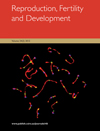Reproduction, Fertility and Development
Volume 24
Number 2 2012
Fertility control has been proposed as a potentially effective management strategy for rodent pests, but the practical methods need to be developed. Our present study reveals that quinestrol (E), alone or in combination with levonorgestrel (EP), induces subfertility in male rats mainly by interfering spermatogenesis. Thus, E and EP may have a bright future in practical usage for rodent pests management.
Bovine embryo quality after in vitro culture is an important determinant of subsequent developmental potential after transfer to recipient animals. We found for the first time that the negative effects of lipoprotein-inclusion and positive effects of antioxidant-inclusion during in vitro culture were reflected in subsequent fetal development. The results emphasise the important of optimising specific culture conditions for subsequent embryo development.
To investigate whether nutrition affects delivery time, we compared the effects of two feeds containing maintenance or higher levels of energy and protein at different points during the latter half of pregnancy on delivery time in rats. We discovered that consuming a maintenance diet during the latter half of pregnancy resulted in a prolonged delivery time.
Vitrification is a crypreservation technique enabling to freeze spermatozoa in a fast and simplified fashion. However, the use of vitrified spermatozoa in assisted reproduction has been limited, and no live births have been reported to date. We report the birth of two healthy babies following ICSI using motile spermatozoa vitrified without permeable cryoprotectants, suggesting that this technique can be successfully applied to achieve normal pregnancy and birth.
Success of embryo transfer is hindered in women and cattle with a low antral follicle count (AFC) because they respond poorly to follicle stimulating hormone (FSH) treatments during superovulation. The present study shows that granulosa cells isolated from follicles of cattle with a low AFC have an inherently reduced capacity to respond to FSH. These findings could lead to new procedures to improve superovulation and success of embryo transfer in individuals with a low AFC.
This research is the first report in which the xenogeneic SSCs could be tolerated in the testes of immunocompetent adult recipients. We found that transplanted rat SSCs could differentiate into spermatozoa in some testes of normal C57BL/6j mice. The SSCs transplantation into immunocompetent recipients may provide more opportunity for practical and medical applications of male infertility.
This study examined the protein expression of enzymes involved in the glycolytic and glycogen pathways in bovine embryos. Results demonstrate that four important glycolytic proteins (HK-I, PFK-1, GAPDH and PKM1/2), the protein transporter GLUT-1 and the glycogenogenetic GSK-3 protein are expressed in bovine embryos as components of glucose energetic metabolism and that the protein expression is critically regulated by PI3-K. Moreover, protein expression of HK-I, PFK-1, GAPDH and PKM1/2, and GSK-3A and GSK-3B phosphorylation is different in male and female bovine embryos, which may be related to the differences in the kinetics of development found between male and female bovine embryos and also could explain the sensitivity of male embryos to high concentrations of glucose.
Sheep with naturally occurring mutations affecting ovulation rate are invaluable models for understanding fertility. This study examined the timing of expression of BMPR1B receptor mRNA in the ovary during fetal development and quantified organelles in oocytes of early stage ovarian follicles in Booroola sheep with a mutation in BMPR1B. Differences in Booroola oocytes from the time the follicles were first formed indicate that this receptor and its ligands play an important role in early follicular development.
Sperm cryopreservation in alpacas in hindered by the viscous nature of the seminal plasma. This viscosity is thought, but never proven, to be caused by glycosaminoglycans secreted from the bulbourethral gland. This study identified the type and source of glycosaminoglycans that may be responsible for alpaca seminal plasma viscosity. Understanding the cause of seminal plasma viscosity will aid the development of protocols for sperm cryopreservation in alpacas and other camelids.
The development competence of oocytes derived from prepubertal animal is compromised as compared to their adult counterparts. The aim of the present study was to identify gene expression profile difference in embryos derived from adult and prepubertal Japanese Black cattle. The identification of differences in transcripts in the prepubertal and adult embryos could represent a valuable tool for the improvement of protocols for the manipulation of prepubertal oocytes, increasing the efficiency in the utilisation of such oocytes.
Transcripts encoding the seven known members of the karyopherin α family of nuclear transporters are present varying levels in porcine oocytes and cleavage stage embryos. KPNA7, an oocyte- and embryo-specific karyopherin α subtype, appears to bind select subsets of intracellular cargoes bearing nuclear localization signals and is required for porcine cleavage development.
In many species, the placenta produces steroid hormones, which play a crucial role in fetal growth and maintenance of pregnancy. In cattle, little is known about the production of these hormones during early gestation. We evaluated the presence of a wide range of steroidogenic genes and proteins in bovine placenta. This study provides new information on the cellular origin of bovine placental steroids, and the steroidogenic capacity of early bovine placenta.
The cloacal gland and its secretion (foam) are believed to have essential roles in the process of quail reproduction, but this has not been confirmed. To highlight the function of the cloacal gland and its foam, we designed the present study to demonstrate that cloacal foam improves sperm transport in the female oviduct and that males with larger cloacal gland areas are preferred during mating.




